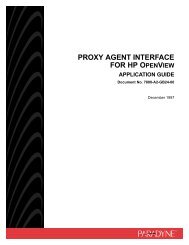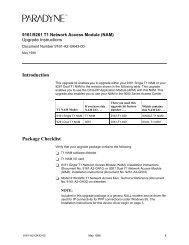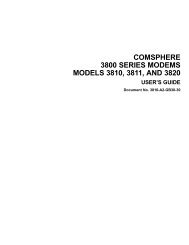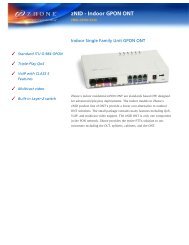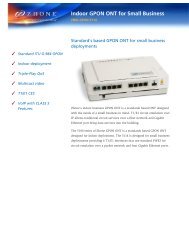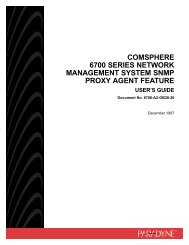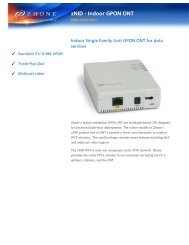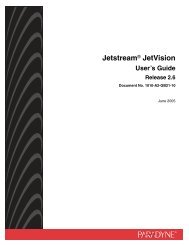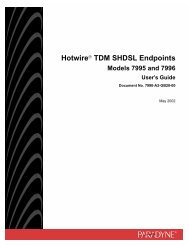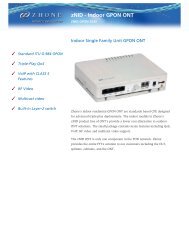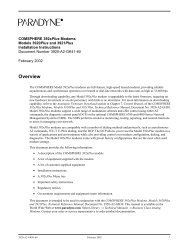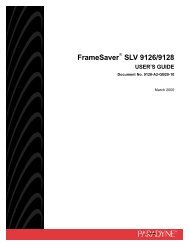VDSL2 Primer - Zhone Technologies
VDSL2 Primer - Zhone Technologies
VDSL2 Primer - Zhone Technologies
You also want an ePaper? Increase the reach of your titles
YUMPU automatically turns print PDFs into web optimized ePapers that Google loves.
Data rate (Mbps)20018016014012010080604020xDSL Performance vs. Loop LengthAggregate data rate (DS+US) for AWGN - 140dBm/Hz00 1 2 3 4 5 6 7 8 9 10Distance (kft)<strong>VDSL2</strong>VDSL1ADSL2+ADSL2xDSL evolution over the years has been driven by the goal of providing increased bandwidthwhile leveraging existing copper. <strong>VDSL2</strong> functions over copper wires in much same way asADSL2+, with some key distinctions. In simplistic terms, while ADSL2+ utilizes 12 MHz ofbandwidth and is limited to speeds of approximately 24 Mbps downstream and 3.3 Mbpsupstream, <strong>VDSL2</strong> utilizes up to 30 MHz of bandwidth to provide speeds of 100 Mbps bothdownstream and upstream within 1,000 ft. Data rates in excess of 25 Mbps are available fordistances up to 4,000 ft. Leveraging existing copper, <strong>VDSL2</strong> can deliver up to 15% improvementover ADSL2+ by avoiding ATM cell overhead.<strong>VDSL2</strong> has provided a major impetus to extend the life of copper networks and enablecost-effective high-bandwidth connectivity. <strong>VDSL2</strong> theoretically doubles (2x) the downstreamdata rates delivered by VDSL and quadruples (4x) those delivered by ADSL2+ networksdepending upon loop length and some other constraints. <strong>VDSL2</strong> is particularly effective inthe Fiber-to-the-Node (FTTN), Fiber-to-the-Building (FTTB) and Fiber-to-the-Curb (FTTC)topology as the service provider reuses existing copper deployed and enables high-speedconnectivity to subscriber homes and businesses utilizing <strong>VDSL2</strong> in the last-mile, with fiberbeing extended to the node, building or curb.Whereas VDSL supported DMT (Discrete Multi-Tone Modulation) in the main body and QAM (Quadrature Amplitude Modulation) in a normativeannex, <strong>VDSL2</strong> was only specified to support DMT modulation. Since the underlying DMT modulation code is the same as ADSL and ADSL2+,<strong>VDSL2</strong> is fully compatible with existing services and enables backward-interoperability with ADSL.<strong>VDSL2</strong> Profiles 8a 8b 8c 8d 12a 12b 17a 30aBandwidth MHz 8.5 12 17.7 30Bandwidth KHz 4.312 4.312 4.312 4.312 4.312 4.312 4.312 8.625Tones D/S 1971 2770 4095 2098TX Power D/S dBm +17.5 +20.5 +11.5 +14.5Maximum Throughput (Mbps,50 68 100 200downstream)As telephone companies replace many of their main feeds with fiber (FTTC/N for example), this presents an opportunity for an additionalapplication of <strong>VDSL2</strong>. By placing a <strong>VDSL2</strong> transceiver in the home and a <strong>VDSL2</strong> DSLAM in a cabinet, the distance constraints that <strong>VDSL2</strong> facespast 1000 ft can be overcome by leveraging fiber. The <strong>VDSL2</strong> DSLAM addresses the analog to digital to analog conversion problem that disablesADSL over fiber, and will convert the data received transmitting it over the fiber back to the CO where it is routed to its final destination. In effect,<strong>VDSL2</strong> is a great fit for service providers deploying fiber across their networks given its ease to connect to these new, fiber networks.Lower frequency <strong>VDSL2</strong> profiles have better performance metrics over longer loops than higher frequencies but at the cost of slower speedsper user. Today the preference is towards <strong>VDSL2</strong> 17a and 30a profiles as some service providers are extending fiber closer to the subscriber andproviding <strong>VDSL2</strong> for the end-points.<strong>VDSL2</strong> 17a Performance vs. Loop Length<strong>VDSL2</strong> 30a Performance vs. Loop LengthData rate (Kbps)140000120000100000800006000040000200000Data rate (Kbps)1400001200001000008000060000400002000000 1000 2000 3000 4000 5000 6000Distance (ft)0 1000 2000 3000 4000 5000 6000Distance (ft)Confined by limited loop length,<strong>VDSL2</strong> 30a is ideally suited for FTTBor FTTH deployments, offering datarate speeds of 100 Mbps, while <strong>VDSL2</strong>17a is ideal for FTTC deployments.As a lower cost option, <strong>VDSL2</strong> 17ais an attractive alternative when thehigher upstream rates of <strong>VDSL2</strong> 30aare not required.DS Line RateUS Line Rate
MX-160 and MX-162 From <strong>Zhone</strong> <strong>Technologies</strong><strong>Zhone</strong>’s MX 160 is a 1U Single Line Multi-Service (SLMS) based IP-DSLAM providing 24-port <strong>VDSL2</strong> 30a high-speed Copper to thePremise (CTTP) connectivity with ADSL2+ fallback and 4x FE/GE uplink ports<strong>Zhone</strong>’s MX 162 is a 1U Single Line Multi-Service (SLMS) based IP-DSLAM providing 24-port <strong>VDSL2</strong> 30a high-speed Copper to thePremise (CTTP) connectivity with ADSL2+ fallback, 4x FE/GE uplink ports and 900 Ohm POTS splittersAs part of the <strong>Zhone</strong> FiberHome portfolio, <strong>Zhone</strong> is providing Fiber-to-the-Node (FTTN), Fiber-to-the-Curb (FTTC) and Fiber-to-the-Building (FTTB) solutions to extend operators’ last-mile reach with high-speed Copper to the Premise (CTTP), wire-speed Ethernet tothe Premise (ETTP) and Fiber to the Premise (FTTP) connectivity to enable advanced broadband and multi-play services.<strong>Zhone</strong> FiberHome portfolio was introduced in early 2011 to address FTTN, FTTB, FTTC and overall FTTx market opportunities. The MX16x platforms are part of the <strong>Zhone</strong> FiberHome portfolio providing high-speed CTTP <strong>VDSL2</strong> 30a connectivity. <strong>Zhone</strong>’s high-speed CTTPsolutions enables up to 100Mbps symmetrical connectivity in areas where fiber directly to the subscriber becomes cost prohibitive. Inthese cases, as an end-to-end solution, <strong>Zhone</strong> offers <strong>VDSL2</strong> CPE and Central Office (CO) products to provide high-speed, long reach andcost-effective solutions for MDUs, remote terminals and CO deployments.In a short span of time, the <strong>Zhone</strong>’s MX 16x platforms have been widely deployed globally and are installed in more than 10 countriestoday including the United States (US), Canada, Japan, United Arab Emirates (UAE), Germany, Norway, Finland, Poland and New Zealand.A key differentiator for the MX 16x platforms is its ability to offer seamless ADSL2+ fallback. ADSL2+ fallback is imperative due to theloop length limitation of <strong>VDSL2</strong>. As the performance diminishes below 100 Mbps symmetrical throughput due to distance limitations, theMX 16x platforms provides a threshold with seamless fallback to ADSL2+ connectivity.Key Differentiators“At Uniserve Communications, the MX-162 hasenabled us to extend the reach of our network in theGreater Vancouver area,” noted Tom Samplonius,vice president of network operations andtechnology, Uniserve Communications. “Ourcustomers are primarily residents in MDUs andbusiness users in commercial and shopping centers.Using <strong>VDSL2</strong>, we have upgraded our network toprovide a high-bandwidth service offering thatimproves the quality and reliability of the end-userexperience. <strong>Zhone</strong> has helped us deliver a solutionthat will provide our customers with high-speedconnectivity while cost-effectively addressing ournetwork migration challenges to support criticalbandwidth needs today and in the future.”• <strong>VDSL2</strong> 30a 100 Mbps symmetrical connectivity• ADSL2+ fallback• 4x FE/GE Uplink Ports• Optional POTS Splitters• Dual Power Inputs• Up to 4 Alarm Inputs• Port Status LEDs• Removable Fan Trays• Link Aggregation, RSTPand EAPS Support



